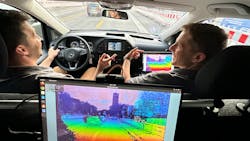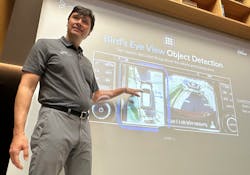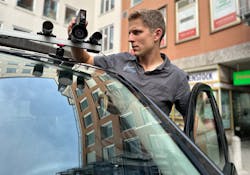Nodar’s new object detection technology offers trucking new view of the road
MUNICH, Germany—Autonomous vehicle vision technology provider Nodar has new capability within its Hammerhead product that offers long-range object detection and tracking for advanced driver assistance systems and AVs.
The system, called GridDetect, works with Hammerhead's long-range, high-resolution sensing capabilities. It can detect and track objects up to 150 meters (1,148 ft.) away and as small as 10 centimeters (4 inches). Nodar executives and engineers demonstrated the GridDetect technology on busy streets surrounding Marienplatz here in the city center to show it could improve ADAS and self-driving technology.
"Our system is 30 times more effective than lidar," Brad Rosen, Nodar's COO, told transportation industry media during a briefing coinciding with the IAA Mobility Conference. "We're getting two to four times the range and 30 times the amount of data as compared to lidar at roughly five to 10 times lower cost."
Leaf Jiang, Nodar's CEO and co-founder, said their software system uses wide-baseline stereo vision cameras and automatic online calibration to provide highly accurate, ultra-long range, real-time depth sensing. The new solution detects and analyzes the road plane while identifying the position, size, and relative velocity of objects and also tracking those objects frame by frame.
See also: California’s AB 316 pushes AV tech into next decade
Jiang said the company is working with OEMs to integrate its software into commercial and passenger ADAS. He said that because of the size of heavy-duty trucks, the stereo vision system can be even more powerful because the two-camera system can provide a broader view. He noted that Roger Nielsen, former CEO of Daimler Truck North America, serves on Nodar's board of directors.
Autonomous vehicles must be able to detect potentially dangerous objects early enough to give them time to avoid the object. As the allowable speed of AVs increases, the distance at which a self-driving vehicle must be able to detect an object increases.
"Range is really, really, really important for trucks—more so than passenger vehicles—because the truck takes so long to stop," Rosen said. "So while a passenger vehicle needs 150 meters in 5 seconds to make a decision, the truck needs 350 meters, and it takes 10 seconds to change lanes. As far as I know, we're the only technology that can really support that in terms of identifying a fallen motorcyclist, for example."
Rosen said that his 5-year-old company is working to build up the brand with vehicle manufacturers. "We primarily sell to the OEMs and will have a design with an OEM," he explained. "They will choose their supplier, and we'll work with that supplier ultimately to integrate our technology."
He said the GridDetect technology would be the dominant AV vision on robotic trucks. He noted that lidar and other systems would be redundant AV technology in self-driving operations.
See also: AEB adoption speeds ahead
Data from the National Highway Traffic Safety Administration (NHTSA) shows the perception and braking challenges along the road:
- At 55 mph, the average driver takes 0.8 seconds to perceive an obstacle ahead while the vehicle travels 120 ft.
- It takes another 0.8 seconds for the driver to brake while the still-moving vehicle travels another 120 ft.
- On dry roadways, an average passenger vehicle takes 4.5 seconds to slow down and stop, traveling another 150 ft.—more than 1,000 ft. for heavy equipment.
- In all, the driver needs nearly 400 ft. to stop the vehicle while traveling at 55 mph.
"Our long-range object detection solution greatly enhances the reliability and safety of self-driving vehicles and ADAS," Jiang said. "The combination of untethered stereo cameras, auto-calibration, and object detection enables exceptionally precise and reliable depth sensing and scene analysis—even at night and in low-visibility weather conditions—which is why our 3D vision technology outperforms all other 3D sensors today, including lidar."
The Nodar software also creates what Jiang called a" bird's-eye view" that allows vehicle systems to see up to 250 meters (820 ft.) away to see other stationary and moving objects along and near the roadways.
About the Author
Josh Fisher
Editor-in-Chief
Editor-in-Chief Josh Fisher has been with FleetOwner since 2017. He covers everything from modern fleet management to operational efficiency, artificial intelligence, autonomous trucking, alternative fuels and powertrains, regulations, and emerging transportation technology. Based in Maryland, he writes the Lane Shift Ahead column about the changing North American transportation landscape.



